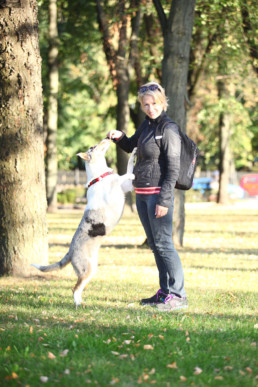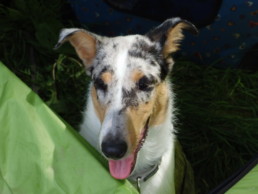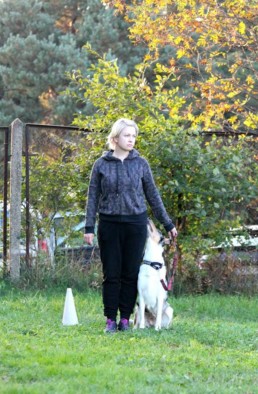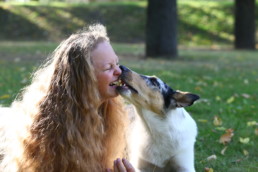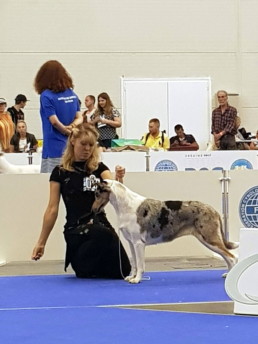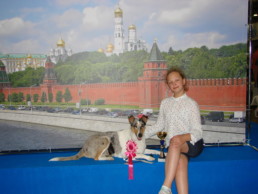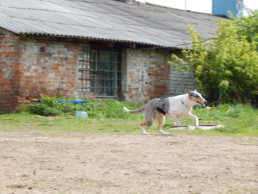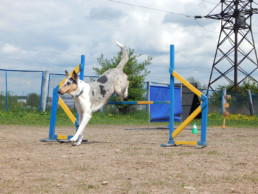Description
Smooth Collies are elegant, active, intelligent dogs. They may be excellent family pets. According to the Kennel Club they are considered a ‘vulnerable breed’ less than 300 puppies registered each year. It`s a pity they are a very versatile breed that deserves to be better known. The Rough Collie has always been more glamorous and better known due to the Lassie films, but the shorter coat of the Smooth Collie should not be overlooked as it is very easy to maintain.
Smooth Collies are wonderful pets because they help to improve our life and do it more interesting and various. They enjoy our life in agility, obedience, heelwork to music, canicross, flyball, showing and rally in addition to working as therapy, assistance and search and rescue dogs.
Opinions differ on this but the Smooth Collie is the same breed as the Rough Collie although the latter developed a long heavy coat to cope with the harsh weather in the Scottish Highlands while the Smooth Collie has a shorter coat more suited to the wetter, milder lowlands. Most people believe that the Smooth Collie was bred to herd sheep or drive cattle, so stamina and endurance give them opportunities to work in all weathers.
Since January 1, 1994 under UK Kennel Club regulations, Rough and Smooth Collies can no longer be interbred and are treated as separate breeds, but their ‘breed standards’ remain the same with the exception of coat length.
The favourite breeds of Queen Victoria were both Rough and Smooth Collies in her kennels in the 19th century.
Smooth Collies should be outgoing and friendly. They are not angry, nervous or aggressive. They are very intelligent and quick to learn and like to please their owners and respond very well to reward based training and do not cope with harsh verbal or physical treatment.
They develop the connection with their families and make excellent companions.They are ready to take part in the life of all family.
Owners describe them as having a good ‘on/off’ switch that makes them very easy to live with as they will do as much as is offered but are quite happy to be calm and relaxed when required.
Smooth Collies are usually very good with other animals and children but do not cope well if left alone for long periods as they can become noisy and distressed as well as lonely. However, like all dogs, they should spend regular short periods of time on their own from puppy onwards to prevent separation anxieties.
The breed is generally very healthy and not known for conditions requiring extensive veterinary care. Like all breeds there are a number of genetic conditions to be considered that can be screened for and hopefully gradually eliminated by careful breeding. The normal range is from 12-14 years.
Smooth Collies are obviously benefit from good quality foods and most breeders should provide relevant information on feeding and recommend something suitable.
Adult Smooth Collies require approximately one hour of exercise per day but will happily take more if offered – exercise should ideally involve some free-running but all dogs benefit from regular sessions on a lead. Good exercises during allow to develop healthily and hopefully prevent problems in later life – the same advice should apply for all breeds.
Breed Standard.
The Kennel Club publishes a ‘standard’ for every pedigree breed registered in the United Kingdom and this is agreed by the individual breed clubs and for the Smooth Collie this is the Smooth Collie Club of Great Britain. This standard describes the ideal characteristics of a breed and is the guideline used for judges in the show ring and breeders when deciding to produce a litter of puppies.
Smooth Collies. Breed Standard.
Last updated October 2009
A Breed Standard is the guideline which describes the ideal characteristics, temperament and appearance including the correct colour of a breed and ensures that the breed is fit for function. Absolute soundness is essential. Breeders and judges should at all times be careful to avoid obvious conditions or exaggerations which would be detrimental in any way to the health, welfare or soundness of this breed. From time to time certain conditions or exaggerations may be considered to have the potential to affect dogs in some breeds adversely, and judges and breeders are requested to refer to the Breed Watch section of the Kennel Club website here http://www.thekennelclub.org.uk/services/public/breed/watch for details of any such current issues. If a feature or quality is desirable it should only be present in the right measure. However if a dog possesses a feature, characteristic or colour described as undesirable or highly undesirable it is strongly recommended that it should not be rewarded in the show ring.
General Appearance
Appears as gifted with intelligence, alertness and activity. Stands with dignity governed by perfect anatomical formation, with no part out of proportion, giving appearance of working capability.
Characteristics
Physical structure on lines of strength and activity, free from cloddiness and with no trace of coarseness. Expression, most important. In considering relative values, it is obtained by perfect balance and combination of skull and foreface, size and shape, colour and placement of eye, correct position and carriage of ears.
Temperament
Gay and friendly, never nervous nor aggressive.
Head and Skull
Head properties of great importance, must be considered in proportion to size of dog. Viewed from front or side, head resembles a well-blunted, clean wedge, being smooth in outline. Skull flat. Sides taper gradually and smoothly from ears to end of black nose, without prominent cheek bones or pinched muzzle. Viewed in profile, top of skull and top of muzzle lie in two parallel straight lines of equal length divided by a slight, but perceptible stop or break. A mid-point between inside corner of eyes (which is centre of a correctly-placed stop) is centre of balance in length of head. End of smooth, well rounded muzzle blunt, never square. Under-jaw strong, clean-cut. Depth of skull from brow to underpart of jaw never excessive (deep through). Nose always black.
Eyes
Very important feature, giving sweet expression. Medium size (never very small), set somewhat obliquely, of almond-shape and dark brown colour, except in case of blue merles when eyes are frequently (one or both, or part of one or both) blue or blue-flecked. Expression full of intelligence, with quick, alert look when listening.
Ears
Moderately large, wider at base, and placed not too close together nor too much on side of head. When in repose carried thrown back, but on alert brought forward and carried semi-erect, that is, with approximately two-thirds of ear standing erect, top third tipping forward naturally, below horizontal.
Mouth
Teeth of good size, jaws strong with a perfect, regular and complete scissor bite, i.e. upper teeth closely overlapping lower teeth and set square to the jaws.
Neck
Muscular, powerful, of fair length; well arched.
Forequarters
Shoulders sloping and well angulated. Forelegs straight and muscular, neither in nor out at elbows, with a moderate amount of bone. Forearm somewhat fleshy, pasterns showing flexibility without weakness.
Body
Slightly long compared with height, back level and firm with slight rise over loins; ribs well sprung; chest deep and fairly broad behind shoulders.
Hindquarters
Hindlegs muscular at thighs, clean and sinewy below, with well bent stifles. Hocks well let down and powerful.
Feet
Oval soles well padded. Toes arched and close together. Hindfeet slightly less arched.
Tail
Long with bone reaching at least to hock joint. To be carried low when quiet but with a slight upward swirl at tip. May be carried gaily when excited, but never over back.
Gait/Movement
Distinctly characteristic of this breed. A sound dog is never out at elbow, yet moves with front feet comparatively close together. Plaiting crossing or rolling are highly undesirable. Hindlegs, from hock joint to ground, when viewed from rear, parallel. Hindlegs powerful and full of drive. Viewed from side, action is smooth. A reasonably long stride is desirable and should be light and appear quite effortless. Absolute soundness is essential.
Coat
Short, flat, topcoat of harsh texture, with very dense undercoat. Not trimmed or clipped.
Colour
Three recognised colours: Sable and white, Tricolour and Blue Merle.
Sable: any shade from light gold to rich mahogany or shaded sable. Light straw or cream colour is highly undesirable.
Tricolour: predominantly black with rich tan markings about the legs and head. A rusty tinge in top coat is highly undesirable.
Blue Merle: predominantly clear, silvery blue, splashed and marbled with black. Rich tan markings preferred but absence should not be penalised. Large black markings, slate colour or rusty tinge top or undercoat are highly undesirable.
All may carry typical white collie markings to a greater or lesser degree. Following markings are favourable: white collar full or part; white front, legs and feet; white tail tip. A blaze may be carried on muzzle or skull, or both. All white or predominantly white is most undesirable.
Size
Height: dogs: 56-61 cms (22-24 ins) at shoulder; bitches: 51-56 cms (20-22 ins) at shoulder. Weight: dogs: 20.5-29.5 kgs (45-65 lbs); bitches: 18-25 kgs (40-55 lbs).
Faults
Any departure from the foregoing points should be considered a fault and the seriousness with which the fault should be regarded should be in exact proportion to its degree and its effect upon the health and welfare of the dog and on the dog’s ability to perform its traditional work.
Note
Male animals should have two apparently normal testicles fully descended into the scrotum.
